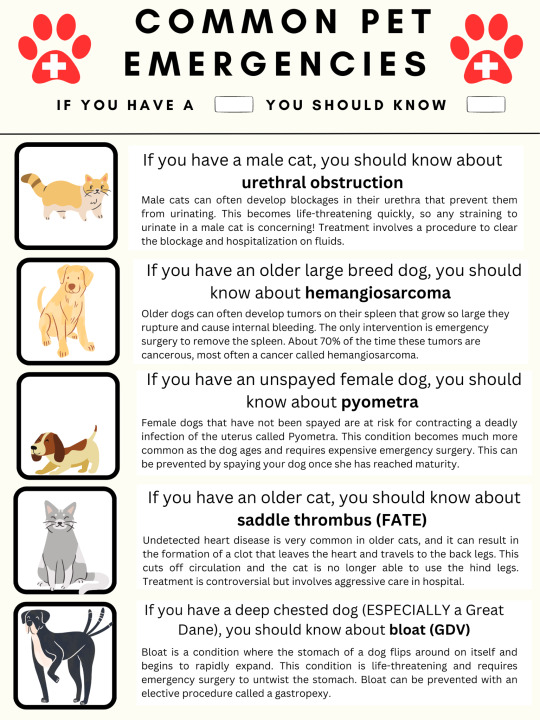by a North American student. Includes: Some study guides and reblogged material that has helped me learn and study for the workplace, and writing the VTNE. I attempt to tag everything relevant in the Tumblr sphere of things. None of this is to be used as a replacement of textbook, or academic sources, and everything can be further source checked upon request. None of this info is to be used to replace, supplement, or dispute Veterinary advice, nor for diagnosis purposes. The language used in some posts is purposely scientific and professionally Veterinary focused as that is the intended audience. Anything stolen, or leaked from individuals will be taken down once I'm informed of such. The intent is purely to provide another free source of study material for Vet Techs and/students who may find it useful. and last but not least by any means, I am a settler descendant on various areas of traditional, treaty, and stolen Native land.
Don't wanna be here? Send us removal request.
Text
Treating fleas
Fleas never really stop being an issue in vet med, but as we in the northern hemisphere are rapidly entering summer, it is once more kicking up in intensity.
In a perfect world, everyone should have their pets on prevention year-round and we'd never have to deal with them, but that's not an achievable outcome.
If your pet does have fleas, you need to treat all pets in the household with effective prevention for at least 3 months while managing the environment. Let me break that down a little further:
"all pets in the household" means every non-human mammal in the house. I don't care if you're only seeing fleas on your one dog - other dogs, cats, ferrets, bunnies, guinea pigs, etc all need to be treated too. All of them.
"effective prevention" unfortunately at least in the US probably means prescription medication, which means your pets have to have a current (generally within last 12 mo) exam on file with a veterinarian. Frontline and other fipronil- or pyrethrin/oid-based products available OTC have become largely ineffective in the last decade or so. I know it's more expensive to get prescription prevention. But I promise it's more expensive in the long run to spend money on products that don't work well and then still have to buy the good stuff afterwards.
"at least 3 months" is because of the flea life cycle and how prevention works. The stuff you give your pets kills the adult fleas when they bite, so they disappear and stop making more fleas. Flea eggs will continue to hatch for a couple months after that. If you treat for less than 3 months you will have the same fleas again. If you stop treating after 3 months you can get fleas again (just like you got them in the first place) but are not guaranteed to.
"managing the environment" means doing what you can to minimize the number of flea eggs that are around. This helps keep your pets comfortable (less itchy) and healthy (reduced risk of illness from fleas). Mostly I have people focus on good household hygiene like vacuuming and washing bedding frequently. If you do use a flea "bomb" product, read the packaging carefully first - most of these are toxic to pets and so have to keep pets out during and for a period of time following treatment.
666 notes
·
View notes
Text

Mainland She Oak Skink (Cyclodomorphus michaeli), mother with pups, family Scincidae, eastern Australia
photograph by Ken Griffiths
11K notes
·
View notes
Text
30K notes
·
View notes
Text
"They only grow to the size of their tank!"
IS A LIE!
THEY WILL GROW AS MUCH AS HEALTHILY POSSIBLE, ALLOWING THEM TO BE ANYTHING LESS THAN THAT DUE TO SMALL ENCLOSURES IS UNHEALTHY, ABUSIVE, AND CRUEL
0 notes
Text

Stinging Moth Caterpillars - North America
238 notes
·
View notes
Text


2002 Cabin Critters Spotted Trout Plush
11K notes
·
View notes
Text
"The 'stretchy dog test' might be a better test, rather than sending a biopsy."
- on diagnosing Ehlers-Danlos in dogs
4K notes
·
View notes
Text
so i'm in this backyard chickens group on reddit and someone just discovered their hen is transitioning and everyone is stoked


anyway in case you didn't know chickens will sometimes spontaneously f2m and it's pretty cool
137K notes
·
View notes
Text
I don't want to make ““doctor’s appointments””and ““schedule a follow up.”” I want to be coaxed gently into a crate and taken to the vet.
102K notes
·
View notes
Text
Not exclusively VetMed studying but good ecology info to know
broke: many worker ants are reproductively viable; the neat division of ants into reproducing queens and nonreproducing workers is a human social construct.
woke: many worker ants are reproductively viable, but the eggs and young of these gamergates are frequently eaten by other workers, and sometimes they are punished for reproducing; the neat division of ants into reproducing queens and nonreproducing workers is socially constructed by ants
6K notes
·
View notes
Text
The best way to prevent undesired behavior in animals is to eliminate the possibility of the animal being put in those circumstances. This in turn means the best way to eliminate undesired behavior in an animal is to remove them from the environment or restrict access to the area of concern.
Example:
You have an anxious dog and your friend asks to bring over their very friendly and playful dog.
You know your dog will not do well since close interactions cause them to lash out in stress and overstimulation.
Your friend suggests that you basket muzzle your dog for the visit, and next time you can meet at a park with the dogs.
In this scenario, a muzzle is considered a (poor) Band-Aid solution because your dog will still experience the anxiety and overstimulation you are concerned about. This has further repercussions when you may later attempt to reintroduce the dogs, regardless of where. On the other hand, rescheduling your visit, or meeting your friend at another location without your own dog present are great alternatives to respect your dogs capabilities, and desires for a secure home area.
By not introducing your dog to triggering situations; you eliminate the potential for undesired behaviours, undue stress, and reactivity.
0 notes
Text
I'll have you know I tell people about dogs unprompted too
people in their twenties be like my hobbies include tv show. substances. Telling people about my chemical romance unprompted
8K notes
·
View notes
Text

[id: tweet by user ziibiing from August 24, 2023 that says “If you share Trump’s mugshot today, please share that the Fulton County Jail it was taken at, is at 3x it’s capacity, infested with bugs, is holding 87% Black people, most of whom haven’t seen a day in court.
Six people have died in custody this year. Fuck cops, fuck jails.” /end id]
25K notes
·
View notes
Text
One of the hardest things about working in a veterinary ER is delivering bad news. I feel like at least once a shift someone is blindsided by their pet being diagnosed with a condition they’ve never heard of before. In many cases this is unavoidable but I really feel that some of the most common critical emergencies I see would be easier for owners to process if they had prior knowledge about the illness.
The following infographic is far from a comprehensive list and truthfully I have a LOT more to say about diagnosis, prevention, and treatment of each of these conditions. However, this image shows just a few of the major points that I wish owners had been able to prepare for prior to hearing about them in the ER. Some of these conditions are preventable and some are not but they all require an owner to make difficult decisions in a crisis situation. If your pet fits into one of these categories, please just do a quick google about the condition, and maybe discuss with your vet signs that you can watch for at home.

12K notes
·
View notes
Photo
For anyone wondering this is motivation and a reminder that Veterinary Medicine must work to be less CIS, white, straight, able-bodied, neurotypically focused in our careers and work environments everyday.

2K notes
·
View notes
Text
Aural refers to ears
Optic refers to eyes
Oral refers to mouth
0 notes
